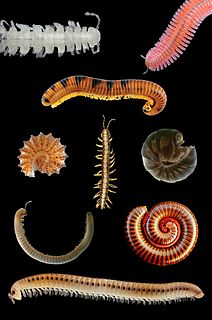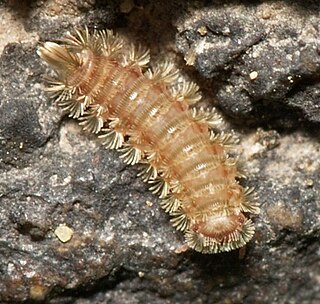
Mistletoe is the common name for obligate hemiparasitic plants in the order Santalales. They are attached to their host tree or shrub by a structure called the haustorium, through which they extract water and nutrients from the host plant.

Millipedes are a group of arthropods that are characterised by having two pairs of jointed legs on most body segments; they are known scientifically as the class Diplopoda, the name derived from this feature. Each double-legged segment is a result of two single segments fused together. Most millipedes have very elongated cylindrical or flattened bodies with more than 20 segments, while pill millipedes are shorter and can roll into a ball. Although the name "millipede" derives from the Latin for "thousand feet", no species was known to have 1,000 or more until the discovery of Eumillipes persephone, which can have over 1,300 legs. There are approximately 12,000 named species classified into 16 orders and around 140 families, making Diplopoda the largest class of myriapods, an arthropod group which also includes centipedes and other multi-legged creatures.

Centipedes are predatory arthropods belonging to the class Chilopoda of the subphylum Myriapoda, an arthropod group which also includes millipedes and other multi-legged creatures. Centipedes are elongated metameric creatures with one pair of legs per body segment. All centipedes are venomous and can inflict painful bites, injecting their venom through pincer-like appendages known as forcipules. Despite the name, centipedes can have a varying number of legs, ranging from 30 to 354. Centipedes always have an odd number of pairs of legs. Consequently, no centipede has exactly 100 legs. Like spiders and scorpions, centipedes are predominantly carnivorous.

Irukandji syndrome is a condition that results from envenomation by certain box jellyfish. In rare instances the sting may result in cardiac arrest and death. The most common jellyfish involved is the Carukia barnesi, a species of Irukandji jellyfish. Those stung may experience severe or even excruciating pain.

The Irukandji jellyfish are any of several similar, extremely venomous species of box jellyfish. With a very small adult size of about a cubic centimetre (1 cm3), they are both the smallest and one of the most venomous jellyfish in the world. They inhabit the northern marine waters of Australia. They are able to fire their stingers into their victim, causing a condition known as Irukandji syndrome, which can be fatal. There are about 16 known species of Irukandji, of which Carukia barnesi, Malo kingi, Malo maxima, Malo filipina and Malo bella are the best-known.

Sphaerotheriida is an order of millipedes in the infraclass Pentazonia, sometimes known as giant pill millipedes. They inhabit Southern Africa, Madagascar, South and Southeast Asia, Australia and New Zealand. Like the Northern Hemisphere pill millipedes of the order Glomerida, these millipedes can roll into a ball when disturbed. When they are rolled-up, most sphaerotheriidans reach a maximum size of a cherry or golf ball, but some species from Madagascar can even reach the size of an orange. When rolled-up, predators are unable to unravel giant pill millipedes since the margins of their second and last dorsal plates fit perfectly into one another, creating a sealed ball. A few giant pill millipede species are able to produce sound, the only millipedes known to do this. This order of millipedes is also unique in that some African species are used for medicinal purposes.

Polyxenida is an order of millipedes readily distinguished by a unique body plan consisting of a soft, non-calcified body ornamented with tufts of bristles – traits that have inspired the common names "bristly millipedes" or "pincushion millipedes". There are at least 86 species in four families worldwide, and are the only living members of the subclass Penicillata.
Polyxenidae is a family of millipedes in the order Polyxenida containing approximately 47 species in 19 genera.

Polyxenus lagurus, known as the bristly millipede is a species of millipede found in many areas of Europe and North America. It is covered with detachable bristles that have the ability to entangle ants and spiders that attack the animal.
Polyxenus is a genus of millipede in the order Polyxenida, containing at least 30 valid species as of 2012.
Synxenidae is a family of bristly millipedes (Polyxenida). Three genera and around 10 species are known. Synxenids possess 15 or 17 pairs of legs, with the last two pair modified for small jumps.
Condexenus is a genus of bristle millipede containing the sole species Condexenus biramipalpus known from Namibia. Individuals are up to 3 mm long, and adults possess 11 body segments and 15 pairs of legs.
Phryssonotus is a genus of bristle millipedes containing around nine extant species. Species are characterized by the possession of dark, rear-projecting scale-shaped bristles (trichomes) on the tergites; all other bristles are long and hairlike.
Lophoproctidae is a family of millipedes in the order Polyxenida containing approximately 65 species in 6 genera.
Transvenidae is a family of parasitic spiny-headed worms in the order Echinorhynchida. This family contains three species divided into two genera.
Sphaeriodesmidae is a family of flat-backed millipedes in the order Polydesmida. There are about 15 genera and at least 90 described species in Sphaeriodesmidae.
Hessebius, is a genus of centipedes belonging to the family Lithobiidae. The genus comprised 17 species.
Macroxenodes is a genus of bristly millipedes in the family Polyxenidae. There are at least four described species in Macroxenodes.







